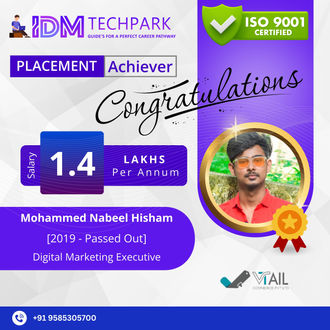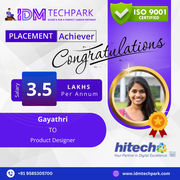Home /J2EE Training In IDM Techpark
J2EE Online Training in Erode
Learn to build enterprise-level web applications with J2EE. Join now to learn from a skilled J2EE developer.
4.75 out of 5 based on 14525 votes
4.2/5
4.8/5
4.6/5
4.3/5
4.5/5
Live Project
Course Duration
80 Hrs.
2 Project
Training Format
Certification Pass
Guranteed
Live Online /Self-Paced/Classroom
GUIDE ME
Speciality
500 +
Professionals Trained
4 +
Batches every month
20+
Countries & Counting
100+
Corporate Served
J2EE Course in Erode
J2EE DevOps is a rapidly evolving field focused on automating the development, deployment, and management of scalable enterprise applications built on the Java 2 Platform, Enterprise Edition (J2EE). It integrates tools like Jenkins, Maven, Gradle, and Git for building and version control, alongside application servers like Apache Tomcat, JBoss, and WebLogic to streamline deployment workflows and foster seamless collaboration between development and operations teams.
By mastering J2EE technologies such as Servlets, JSP, EJB, and frameworks like Spring and Hibernate, combined with CI/CD practices, containerization using Docker, orchestration with Kubernetes, and monitoring with tools like Prometheus and ELK Stack, professionals can deliver robust, scalable, and secure enterprise solutions. With applications in large-scale enterprise system development, cloud deployment, application scaling, security, and automation, J2EE DevOps is transforming how organizations build and maintain high-quality, mission-critical software systems.


Training Features of J2EE course in Erode
Students Placements & Reviews
What are the skills required in J2EE course in Erode?
Who Can Enroll in the J2EE Course in Erode?
There are no strict prerequisites to join the course. However, ideal candidates include:
J2EE Course Fees & Enrollment
Flexible payment options available.
EMI and installment plans for easy accessibility.
Follow us on Instagram & Telegram for updates on new courses and discounts.
50+ Advanced Modules Covered
- 01
- 02
- 03
- 04
- 05

Looking for in-depth syllabus Information ?
Course Highlights and Why J2EE Course in Erode at IDM Techpark?
Comprehensive J2EE Training – IDM Techpark offers in-depth J2EE training covering Servlets, JSP, EJB, Hibernate, and Spring Framework to help students build enterprise-level applications. The course equips learners with the skills needed to develop scalable, secure, and high-performance Java applications.
Industry-Aligned Curriculum – The J2EE course is designed by industry experts to provide in-depth knowledge of Java Servlets, JSP, EJB, and Spring Framework, ensuring students gain essential skills for building scalable enterprise applications.
Hands-on Learning Approach – IDM Techpark provides an intensive learning experience with practical, hands-on coding sessions to help you master programming languages effectively.
Regular Recap Sessions – After each class, students receive recap sessions to reinforce key J2EE concepts, including Servlets, JSP, and EJB, ensuring a solid understanding of enterprise application development.
Flexible Batch Schedules – IDM Techpark offers flexible training schedules, including weekday, weekend, and fast-track batches, allowing learners to choose the best timing that suits their availability.
Real-Time Project Exposure – The training includes working on live projects to gain practical experience, ensuring that learners are industry-ready with hands-on project development skills.
100% Placement Assistance – IDM Techpark has strong tie-ups with over 3000 companies, providing extensive placement support and career guidance to help students secure high-paying jobs in the industry.
J2EE Course Objectives
-
Mastering J2EE Fundamentals – Build a strong foundation in Java EE, including Servlets, JSP, and JDBC, essential for developing enterprise applications.
-
Proficiency in Web Application Development – Learn to create dynamic web applications using JSP, Servlets, and JSF, along with frontend integration.
-
Enterprise Backend Development – Gain hands-on experience with EJB, Hibernate, and Spring Frameworks to develop scalable backend solutions.
-
Database Management Mastery – Work with MySQL, Oracle, and MS-SQL, leveraging JPA and Hibernate for efficient data handling.
-
API Development & Integration – Learn to develop and integrate RESTful and SOAP APIs for seamless communication between distributed systems.
J2EE Course Trainer Profile
Industry-Experienced Trainers – Our J2EE trainers are seasoned professionals with extensive knowledge of Java EE technologies, enterprise application development, and frameworks like Spring, Hibernate, and JSP. They provide hands-on experience to help students master the J2EE ecosystem.
Comprehensive Student Guidance – Our experienced trainers offer in-depth mentorship to help students master J2EE technologies, ensuring a solid understanding of enterprise application development and deployment.
Hands-on Practical Training – Students work on real-world J2EE projects, gaining experience in building dynamic, enterprise-level applications using Servlets, JSP, and JavaBeans.
Industry-Relevant Frameworks – Instructors introduce students to key J2EE frameworks like Spring, Hibernate, and Struts, essential for building robust enterprise applications. These frameworks equip students with the skills needed to develop scalable, secure, and high-performance Java-based solutions.
Regular Progress Assessments – Trainers conduct periodic evaluations and assessments to track each student's learning progress and provide necessary improvements.

Student Success Story of J2EE Course in Erode
Ravi, an MSc Computer Science graduate, initially worked in the technical support domain for a year. However, he soon realized that it wasn’t the right career path for him. Determined to advance his skills, he discussed his career goals with a friend and conducted thorough research to find the best learning opportunity that aligned with his passion for software development, specifically J2EE development.
Since he was already working, Ravi opted for weekend classes to balance his job and studies effectively. With dedication and enthusiasm, he attended every session and successfully completed capstone projects under the mentorship of experienced trainers.
Upon completing the course, Ravi participated in placement training provided by IDM Techpark. He then attended interviews with NTT Data and ITSS Global. Eventually, he accepted a J2EE Developer role at NTT Data with a salary package of 2.8 LPA, marking the start of his successful journey in the IT industry.

Have Queries? Talk to our Career Counselor for more Guidance on picking the
right Career for you!
J2EE Certification Training in Erode
Upon successfully completing the J2EE Development Course in Erode at IDM Techpark, students will receive a certification from the institute. This certification serves as concrete proof of the industry-relevant skills and comprehensive knowledge acquired during the course. It validates their expertise and grants professional recognition, enhancing their credibility in the job market. Additionally, the certification reflects the student’s performance in practical training and evaluative examinations, providing an overview of their proficiency in J2EE development.
The J2EE Developer Course at IDM Techpark holds a strong reputation in the industry and is widely recognized by both national and international organizations. Adding this certification to your resume will significantly boost your career prospects. With this qualification, trainees become highly competitive candidates for job interviews across various IT sectors, as the certification is a testament to their skills and knowledge. The course is designed to align with industry best practices, leveraging cutting-edge technology and an up-to-date curriculum.
Under the expert guidance of our faculty, students will develop the necessary skills to efficiently build scalable web applications using J2EE technologies. The J2EE Developer Course at IDM Techpark is structured to strengthen technical capabilities and refine the problem-solving skills of learners. Earning this certification will elevate your professional profile, unlocking new career opportunities in the IT industry.
Placement Session & Job Opportunities after completing J2EE Course in Erode
Growing Demand for J2EE Developers – IDM Techpark, Erode
As technology continues to evolve with no foreseeable endpoint, businesses are prioritizing software development to meet the ever-growing demands of their customers. This digital transformation has significantly increased the demand for J2EE Developers across various industries. Many startups, aiming to optimize costs and efficiency, prefer hiring J2EE Developers to build robust, scalable enterprise applications.
The need for J2EE Developers is not limited to startups or mid-sized companies; even large multinational corporations actively seek professionals with specialized skills. Their expertise in Java-based enterprise solutions makes them valuable assets in various aspects of business growth.
At IDM Techpark, Erode, we are committed to equipping students with the necessary expertise to capitalize on these vast career opportunities.
“Students will receive 100% placement assistance upon completing the J2EE Developer Training at IDM Techpark.”
J2EE Developers enjoy higher salary packages, stable career growth, and strong job security compared to other developers in the market. Their proficiency in developing enterprise-grade applications also provides them with opportunities to take on freelance projects, further increasing their earning potential.By enrolling in the J2EE Developer Course at IDM Techpark, Erode, students can gain the skills and industry exposure needed to thrive in this competitive and rapidly evolving tech landscape.
The increasing shift towards digital transformation across various industries has created an insatiable demand for skilled J2EE Developers. Enterprises are actively investing in Java-based solutions for building scalable, high-performance applications that cater to their diverse business needs. J2EE remains the go-to platform for developing large-scale web applications, offering robust frameworks, security features, and scalability for complex business solutions.





























.avif)



















